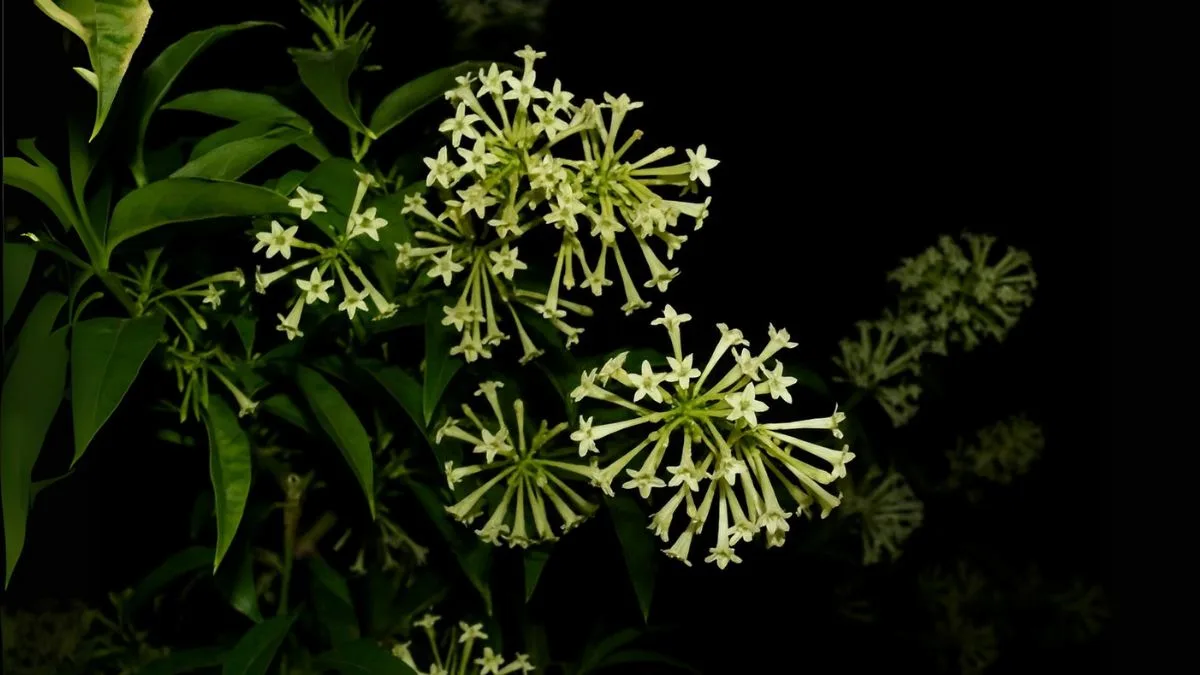If you’ve ever grown Raat Rani (Night Queen jasmine) in your garden, you already know the mesmerizing fragrance it releases after sunset. This small yet intensely scented flower has been a favorite in Indian homes for centuries. But along with admiration comes a common fear: “Does Raat Rani attract snakes?”
This belief has been passed down for generations, often discouraging gardeners from planting this otherwise delightful shrub. Let’s break down the myth and uncover the facts.
Understanding the Raat Rani Plant

What is Raat Rani?
The Night blooming Jasmine – Raat ki rani flower is scientifically known as Cestrum nocturnum. It is a hardy evergreen shrub that produces clusters of small, greenish-white flowers that bloom at night.
- Known for its intoxicating scent, especially strong after dusk.
- Popularly used in gardens and courtyards across India and also admired in the USA and Canada.
- Symbolizes beauty, mystery, and spiritual connection.
The Myth: Raat Ki Rani Attracts Snakes
Across many households, elders warn that Raat Ki Rani attracts snakes. The reasoning is usually tied to its fragrance.
- Yes, snakes are attracted by the pleasant and strong fragrance of jasmine flowers, according to common belief.
- People often connect nighttime snake appearances in gardens with the blooming of this plant.
- Fear leads some families to avoid planting this beauty in courtyards or near entryways.
But is this really true?
Also Read: The Morning Glory Plant: A Morning Mystique
The Science: Does Raat Rani Actually Attract Snakes?
Here’s the reality: No, Raat Rani (Night Queen jasmine) does not directly attract snakes.
Snakes do not have noses like humans; they don’t get “pulled” by scents in the way we imagine. Instead, they use their forked tongues to collect airborne particles and analyze them through the Jacobson’s organ. While strong fragrances may alert them to chemical changes in the environment, flowers are not their natural attraction.
What Snakes Actually Seek:
- Shelter – Cool, damp areas such as under rocks, pots, or thick bushes.
- Food – Rodents, frogs, insects, and lizards.
- Moisture – Especially in hot summer months.
So, if snakes are seen near Raat Rani, it’s not the plant itself but possibly the environment around it that provides shelter or prey.
Why the Myth Persists
Despite scientific facts, cultural beliefs hold strong. The intense fragrance of Night blooming Jasmine – Raat ki rani flower is unique, and its timing (late evening) overlaps with when snakes are more active. This coincidence fuels the association.
Also, in rural India, gardens with dense shrubs and poor lighting naturally attract reptiles. When snakes are spotted there, the blame often falls on the most noticeable plant – in this case, Raat Rani.
Myth vs Fact about Raat Rani and Snakes
Belief |
Reality |
Raat Ki Rani attracts snakes because of its fragrance. |
No, Raat Rani does not directly attract snakes. Snakes seek food, water, and shelter, not flowers. |
Snakes love jasmine flowers. |
Snakes don’t feed on flowers. Their diet consists of rodents, frogs, and insects. |
Planting Raat Rani near homes is unsafe. |
Planting is safe. Just maintain cleanliness and avoid rodent activity. |
Safe Gardening with Raat Rani
If you love the fragrance but fear the myth, here are some practical tips:
- Location Matters – Plant Raat Rani in well-lit areas away from damp corners.
- Garden Hygiene – Remove piles of wood, stones, or debris where snakes could hide.
- Control Rodents – Since rodents attract snakes, keeping them away reduces risks.
- Use Raised Pots – Growing in containers makes it easier to manage surroundings.
- Regular Trimming – Keeps the shrub neat and reduces dense hiding spots.
Also Read: Why Herbalists Love Hawthorn—And How You Can Grow It Too
Personal Experience with Raat Rani
I planted a Night blooming Jasmine – Raat ki rani flower in my backyard two years ago. Initially, my neighbors warned me: “Don’t plant it; it attracts snakes.” But curiosity won.
Over time, I realized that while the fragrance filled the air, I never saw snakes near it. What I did notice was that areas with stored firewood nearby often had reptile activity, not the plant itself. Today, my Raat Rani is one of the most admired plants in the neighborhood, proof that the myth doesn’t hold true in real gardening practice.
Global Perspective
Interestingly, the myth isn’t widespread outside South Asia. In places like Canada and the USA, where Raat Rani (Night Queen jasmine) is grown as an ornamental or indoor plant, the association with snakes doesn’t exist. Instead, it’s cherished for its powerful scent and ability to thrive in warm climates.
If you’ve been hesitating to plant this fragrant shrub, let go of the fear. Instead, enjoy the beauty, the pleasant and strong fragrance of jasmine flowers, and the cultural charm it brings to your home. Plant your Raat Rani with pride. Maintain garden hygiene, avoid clutter, and you’ll have nothing to fear—only evenings filled with a fragrance that’s truly magical.






